Translate this page into:
Assessing the influence of planting time and fertilization on growth, flowering, yield and soil properties of chrysanthemum
⁎Corresponding author. choudharyansh209@gmail.com (Anshul Kumar)
-
Received: ,
Accepted: ,
This article was originally published by Elsevier and was migrated to Scientific Scholar after the change of Publisher.
Abstract
Objectives
To identify optimal planting time for maximizing growth and flowering, and assess the impacts of various fertilization techniques on plant growth and soil health in chrysanthemum.
Methods
The investigation was conducted at Dr. Y.S. Parmar University of Horticulture and Forestry in Nauni, Solan, Himachal Pradesh, India from 2022 to 2023. The study aimed to investigate the impact of various planting times and fertilization schedules on the yield, quality, and soil health characteristics of chrysanthemum. Different planting times from 15 June to 30 August under organic and inorganic fertilization regimes were evaluated. Data related to vegetative growth, flowering, soil chemical and biological properties were recorded.
Results
Planting on 15 June along with inorganic fertilization resulted in improved vegetative characters like plant height (74.37 cm) and plant spread (30.56 cm), flowering characters like cut flower stem length (64.07 cm), stem strength (10.40°), flower diameter (11.80 cm) and duration of flowering (22.50 days) and soil chemical properties like available N, P, K (326.53, 40.36 and 359.48 kg/ha, respectively). However, planting on June 15 combined with organic fertilization led to enhancement in soil microbiological properties, including bacterial count (138.33 cfu/g soil), fungal count (31.75 cfu/g soil), actinomycetes count (62.46 cfu/g soil), microbial biomass (52.62 µg/g soil) as well as vase life (19.70 days).
Conclusion
In the present study, it was found that planting time and fertilization significantly impacted chrysanthemum growth, yield and soil properties. The 15 June planting with inorganic fertilization boosted growth, yield and macronutrient content, while organic fertilization on the same date enhanced soil microflora. Flowering was influenced by planting time and organic fertilization showed promise as an alternative to chemical fertilization. Optimizing planting schedules and using organic fertilizers would lead to sustainability and offer economically viable alternatives to conventional crop management.
Keywords
Chrysanthemum
Cut flower
Sustainable farming
Soil health
Yield and Quality
Data availability
Data will be made available on request.
1 Introduction
Chrysanthemum is one of the most important flower crops in Asteraceae family and holds significant value for its varied forms, vibrant colors and prolonged vase life (Mekapogu et al., 2022). It occupies the second position among the top ten cut flowers after the rose (Darras, 2021). Chrysanthemum holds economic significance in India as it has a major share in the export market along with supporting the local economies of the country.
Chrysanthemum plant, classified as a qualitative short-day plant, has a restricted availability period of around 13 weeks (Van-Der Ploeg and Heuvelink, 2006). Synchronous planting of it can lead to an oversupply in the market, resulting in decreased prices. By implementing planting date scheduling, market volatility can be mitigated through controlled bloom periods, thereby, increasing demand and yielding higher market prices.
Optimal fertilizer application is crucial for plant development, growth and quality (Fageria et al., 2008). Intensive farming and use of agrochemicals cause environmental pollution, impacting human health (Mandal et al., 2020). The shift towards organic agriculture emphasizes ecosystem health and the demand for chemical-free products (Pandey and Singh, 2012). Organic manure provides essential nutrients and enhances the soil physico-chemical and biological properties (Yamada and Xu, 2001).
Jeevamrit, an organic amendment rich in macro and micronutrients and beneficial microorganisms, enhances soil biological activity and nutrient availability, promoting crop growth and environmental sustainability (Rathore et al., 2023). Supporting eco-friendly practices reduces the costs of chemical fertilizers and pesticides and boosts production economics, benefiting small and marginal farmers (Saharan et al., 2023).
This study analyses the impact of planting time and nutrition on chrysanthemum production and quality, hypothesizing that inorganic fertilization boosts growth and yield, while organic fertilization enhances soil microflora. Furthermore, planting time can be manipulated to regulate flowering times. Previous studies have primarily focused on the individual effects of planting time or fertilization types on chrysanthemum cultivation. However, there is a lack of comprehensive research that integrates these factors to provide a holistic understanding of their combined impact. This study addresses this gap by simultaneously examining the effects of planting time and different fertilization methods, thus contributing to a more nuanced understanding of chrysanthemum cultivation.
2 Material and methods
Experimental site: The study was carried out at the experimental farm of Dr. Y. S. Parmar University of Horticulture and Forestry, Nauni, Solan, India in 2022 and 2023. The farm is situated at an elevation of 1,276 m above mean sea level, at coordinates 30°51′0′' N latitude and 77°11′30′' E longitude (Fig. 1).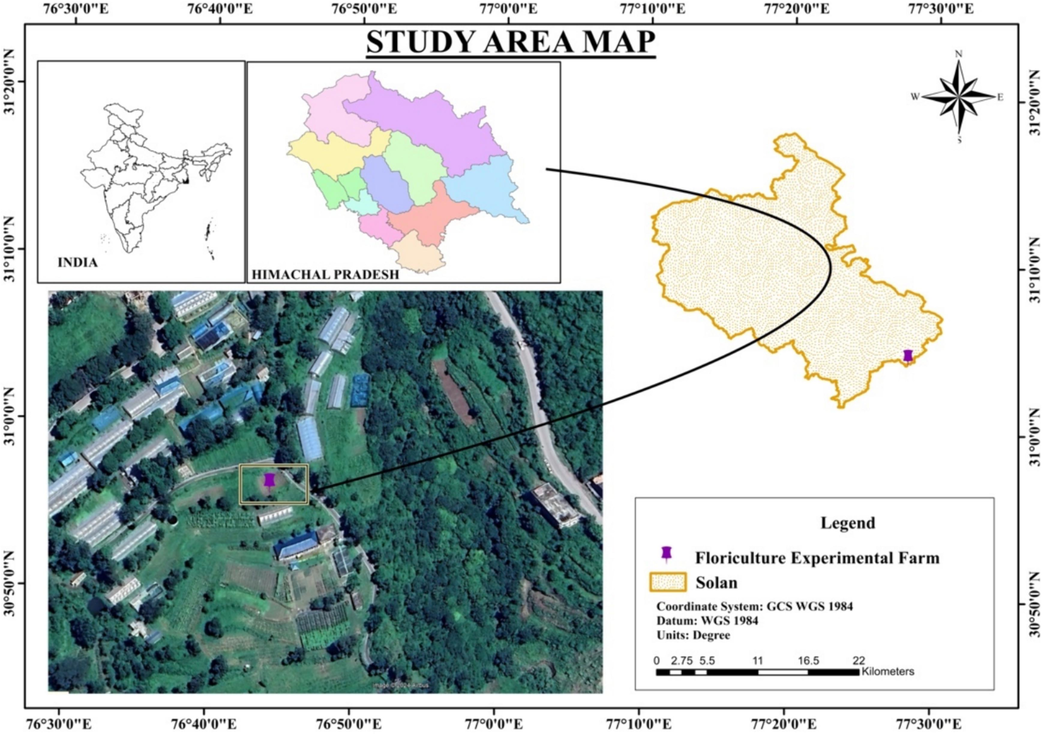
Location of experimental farm where research trial was conducted.
Planting material: Shoot tip cuttings of chrysanthemum cv. ‘Purnima’ were prepared from a healthy mother block by following standard practices. Rooted cuttings were used for transplanting.
3 Experimental conditions
The experimental field was ploughed up to a depth of 0.30 m. Well-decomposed farmyard manure (FYM) was incorporated @ 5 kg/m2. Raised beds, each measuring 1 m2 and 6 in. in height, were prepared. Cuttings were planted on different dates with 15 days intervals. For inorganic fertilization, a basal dose of 30 g/m2 NPK was applied during bed preparation (half of the dose of N, along with full doses of P and K, was applied). The remaining half dose of N (15 g/m2) was added to the soil 45 days after planting. For organic fertilization, Jeevamrit was applied via drenching @ 30 ml/plant, beginning 30 days after transplanting, using a 1:4 dilution ratio.
The experiment was laid out in a randomized block design (RBD) with 12 treatments, each replicated thrice, in a factorial arrangement (Fig. 2). The factors included planting time (P1: 15 June, P2: 30 June, P3: 15 July, P4: 30 July, P5: 15 August, P6: 30 August) and fertilization regimes (FM1: Jeevamrit at 30 ml plant−1, FM2: NPK at 30 g/m2). Planting at 30 cm × 30 cm spacing included 9 plants/m2 for June and July plantings, and 49 plants/m2 for August plantings. Pinching was done only in plots with 9 plants/m2, promoting multi-stemmed branching, while no pinching was done in plots with 49 plants/m2.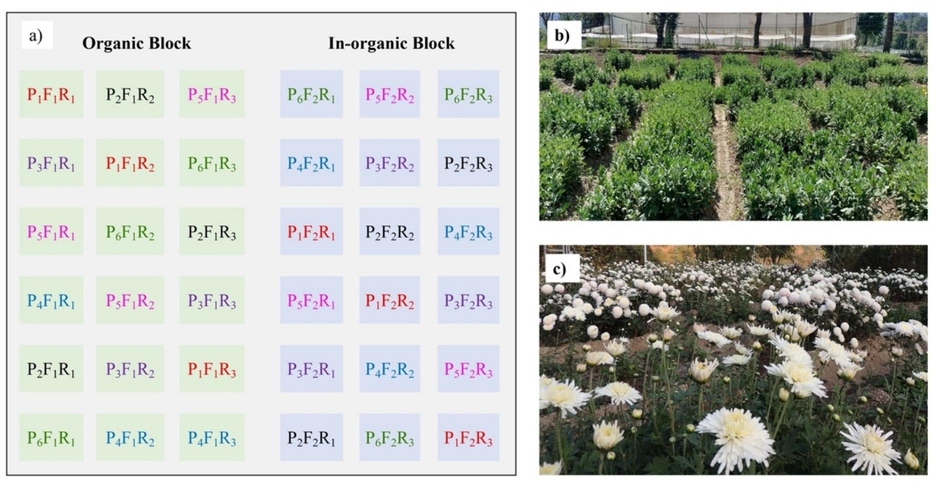
(a) An experimental layout showing six different planting dates (P1-P6), two fertilization regimes (F1 and F2), each replicated three times (R1-R3). (b) A vegetative overview of the field. (c) A flowering overview of the field.
3.1 Vegetative and flowering characteristics
Data were collected on randomly selected five plants from each replication and different vegetative characters (such as plant height and spread, measured with a metre rod) and flowering attributes (days taken to bud formation and stage of harvesting) were observed from the date of planting. The number of cut stems per plot was counted manually, cut flower stem length using a metre rod, flower diameter using vernier calipers; stem strength as deviation angle when placed horizontally, vase life in distilled water under room temperature and duration of flowering at harvesting of 1st cut stem till the harvesting of last cut stem).
3.2 Chemical properties
Soil samples were taken from the study area at a depth of 0 to 15 cm before laying out the experiment. Soil pH and EC were measured using 1:2 soil water suspension and were found 6.85 and 0.34 dS/m, respectively (Jackson, 1973). Soil organic carbon was determined as per Walkley and Black (1934) which was 0.92 % (rapid titration method). Available nitrogen was found 292.76 kg/ha (Subbiah and Asija, 1956). Available phosphorus was recorded 27.48 kg/ha (Olsen et al., 1954) and available potassium was recorded 315.84 kg/ha (Merwin and Peech, 1951).
3.3 Soil microbial attributes
Microbial quantification was performed using the serial dilution standard spread plate technique on three different media: nutrient agar, potato dextrose agar and Kenknight and Munaier's medium, following the protocol outlined by Subbarao (1995). The microbial population was quantified as colony-forming units per gram of soil. Additionally, microbial biomass-C was assessed using the soil fumigation extraction method given by Vance et al. (1987). where, K: 0.25 ± 0.05 (a measure of the effectiveness of microbial biomass carbon extraction), EC (F): Amount of extractable carbon in soil samples post-fumigation, EC (UF): Total extractable carbon in un-fumigated soil samples.
The dehydrogenase activity in liquid formulations was calculated using the 2,3,5-triphenyl tetrazolium chloride reduction method (Casida et al., 1964) and phosphatase activity was measured according to the procedure detailed by Tabatabai and Bremner (1969).
3.4 Statistical techniques and analysis
The data collected during the two years of experimentation in 2022 and 2023 were pooled and analyzed using SPSS statistics. Analysis of variance (ANOVA) was performed on the pooled data employing randomized block design (RBD) and the treatments were compared using the critical difference at 5 % level of significance.
4 Results
4.1 Vegetative and flowering characteristics
Planting time and fertilization regimes had a significant effect on vegetative characteristics of chrysanthemum (Table 1). Among different planting times, highest plant height (71.06 cm) and spread (29.06 cm) were observed in P1 as compared to other planting dates. FM2 recorded the higher plant height (53.93 cm) and spread (20.57 cm) over FM1 which recorded plant height of 47.79 cm and plant spread of 18.46 cm. Under the interaction effect, highest plant height (74.37 cm) and spread (30.56 cm) were recorded under P1xFM2. * Non-significant differences (DMRT, 5% significance) are denoted by identical letters within each column.
Treatments
Plant height (cm)
Plant Spread (cm)
Days to bud formation (days)
Days taken to harvesting (days)
Cut stems/plot
Cut flower stem length (cm)
Flower Diameter (cm)
Stem Strength
(°)
Flowering duration(days)
Vase Life
(days)
Planting time
P1
71.06a
29.06a
95.33a
142.93a
41.55b
61.00a
11.03a
10.83c
21.50a
18.92a
P2
65.71b
26.32b
81.78b
130.95b
38.25c
55.56b
10.47b
11.25c
20.50ab
18.27b
P3
57.59c
22.95c
68.73c
117.33c
33.75d
48.26c
9.79c
12.47bc
20.08ab
17.37c
P4
45.70d
20.84d
56.02d
105.53d
32.25d
38.97d
9.06d
12.9b
18.00bc
16.43d
P5
35.59e
9.19e
43.88e
92.76e
49.00a
29.72e
8.45e
15.72a
17.17c
15.70e
P6
29.51f
8.76f
32.45f
79.58f
49.00a
24.10f
7.77f
16.2a
16.17c
15.05f
Significance
0.45
0.42
0.64
1.04
1.69
1.45
0.23
1.05
1.91
0.24
Fertilization
FM1
47.79a
18.46a
64.22a
112.83a
40.08a
39.79a
8.90a
12.92a
18.22a
17.97a
FM2
53.93b
20.57b
61.85b
110.20b
41.18b
46.09b
9.95b
13.53b
19.58b
15.94b
Significance
0.77
0.72
0.37
0.60
0.98
0.84
0.13
0.60
1.10
0.14
Interaction
P1xFM1
67.76b
27.56b
96.97a
143.80
40.80
57.93
10.26c
11.27
20.50
19.7a
P2xFM1
63.52c
25.40c
83.33c
132.63
37.20
53.03
9.9d
11.87
19.50
19.27b
P3xFM1
54.90e
21.22e
70.17e
118.97
33.00
45.66
9.26e
12.60
19.00
18.6c
P4xFM1
42.19 g
19.42f
57.1g
106.93
31.50
35.96
8.82f
13.10
17.33
17.4e
P5xFM1
31.83i
8.69gh
44.7i
94.37
49.00
25.97
7.93h
15.97
16.83
16.73f
P6xFM1
26.52j
8.49h
33.03k
80.27
49.00
20.17
7.27i
16.40
16.17
16.1g
P1xFM2
74.37a
30.56a
93.7b
142.07
42.30
64.07
11.8a
10.40
22.50
18.13d
P2xFM2
67.91b
27.24b
80.23d
129.27
39.30
58.09
11.03b
10.63
21.50
17.27e
P3xFM2
60.29d
24.68c
67.3f
115.70
34.50
50.86
10.31c
12.33
21.17
16.13g
P4xFM2
49.20f
22.26d
54.93h
104.13
33.00
41.98
9.31e
12.70
18.67
15.47h
P5xFM2
39.34 h
9.68g
43.07j
91.14
49.00
33.47
8.98ef
15.47
17.50
14.67i
P6xFM2
32.50i
9.02gh
31.87l
78.90
49.00
28.04
8.28g
16.00
16.17
14j
Significance
1.09
1.02
0.91
NS
NS
NS
0.32
NS
NS
0.34
Data embodied in Table 1 show that the earliest bud formation (32.45 days) and time to reach the harvesting stage (79.58 days) were recorded in P6. Maximum cut stems/plot (49.00) were recorded under P5 and P6. Maximum stem length of cut flower (61.00 cm), flower diameter (11.03 cm), stem strength (10.83°), flowering duration (21.50 days) and vase life (18.92 days) were observed under P1.
Earlier bud formation (61.85 days), lesser period taken to reach the harvesting stage (110.20 days) and more cut stems/plot (41.18), stem length of cut flower (46.09 cm), flower diameter (9.95 cm), stem strength (13.53°) and flowering duration (19.58 days) were observed in FM2. FM1 recorded higher vase life (17.97 days).
The interaction effect of dates of planting and fertilization regimes revealed that the earliest bud formation (31.87 days) was observed in P6xFM2. Maximum flower diameter (11.80 cm) was recorded in P1xFM2 and vase life (19.70 days) in P1xFM1.
4.2 Soil chemical properties
Maximum available N, P and K (318.81, 38.08 and 352.47 kg/ha, respectively) was observed in P1 in comparison to all other planting times (Fig. 3). FM2 resulted in maximum available N, P and K (321.71, 38.48 and 353.29 kg/ha, respectively) (Fig. 4). The interaction was found non-significant (Fig. 5).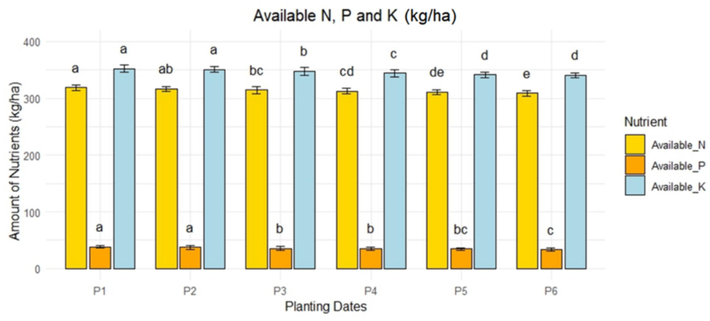
Impact of planting time on soil available NPK.
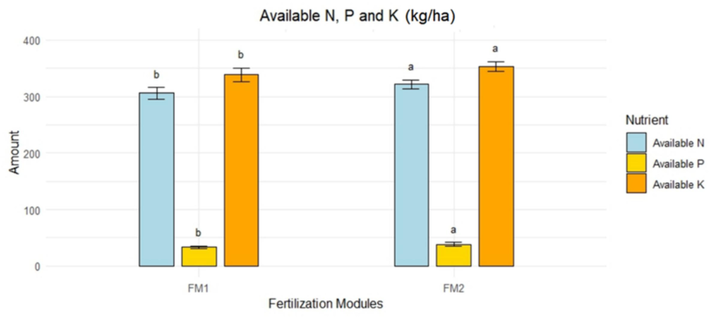
Impact of fertilization regimes on soil available NPK (Pooled Data: 2022 & 2023).
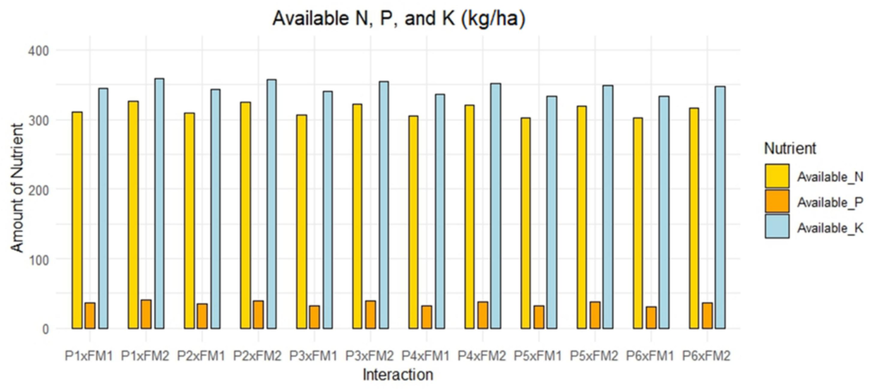
Interaction impact of planting time and fertilization regimes on soil available NPK (Pooled Data: 2022 & 2023).
During both study years, fertilizer regimes and planting days had non-significant effects on soil pH and EC (Figs. 6-8). Among different planting time, maximum OC (1.14 %) was observed in P1 planting compared with all other planting time (Fig. 6). Organic fertilization recorded maximum OC (1.13 %) (Fig. 7). The interaction effect on OC was found to be non-significant (Fig. 8).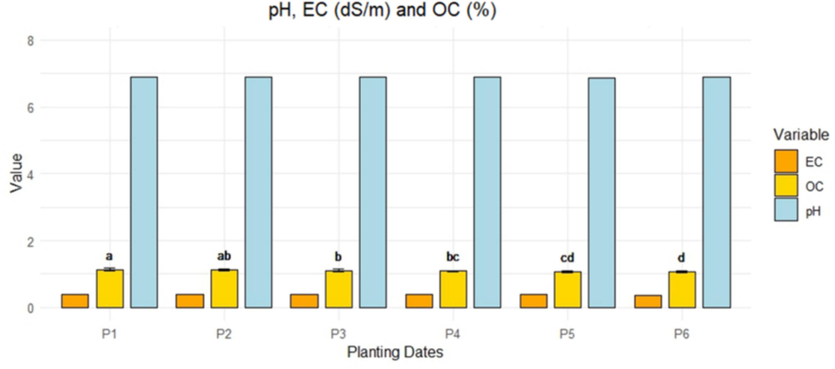
Impact of planting time on soil pH, EC and OC (Pooled Data: 2022 & 2023).
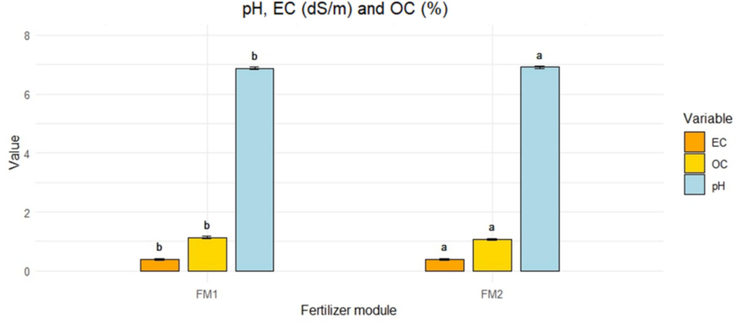
Impact of fertilization regimes on soil pH, EC and OC (Pooled Data: 2022 & 2023).
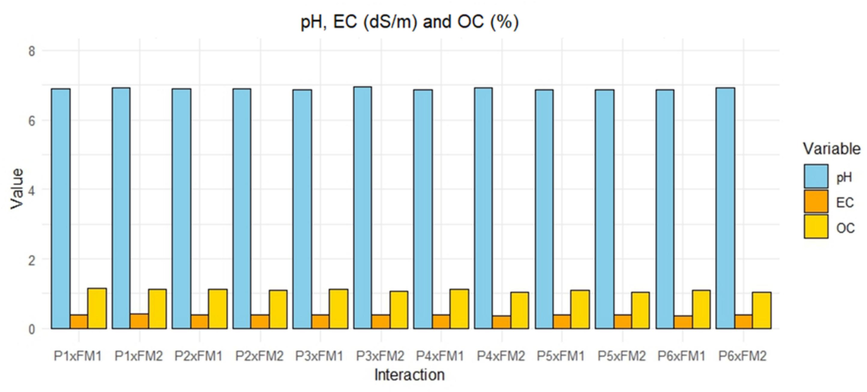
Interaction impact of planting time and fertilization regimes on soil pH, EC and OC.
4.3 Soil microbiological properties
Data presented in Table 2 show that planting time had a non-significant effect on all the soil microbiological properties. Among different planting times, maximum dehydrogenase enzyme was recorded in P1 (3.69 mg TPF/h/g/soil, respectively). Maximum phosphatase enzyme (24.20 mmole PNP/h/g/soil, respectively) was recorded under P1. * Non-significant differences (DMRT, 5% significance) are denoted by identical letters within each column.
Treatments
Bacterial Count
(cfu/g soil)
Actinomycetes Count
(cfu/g soil)
Fungal Count
(cfu/g soil)
Microbial Biomass
(µg/g soil)
Dehydrogenase enzyme
(mgTPF/h/g soil)
Phosphatase enzyme
(mmole PNP/h/g soil)
Planting time
P1
116.94
61.12
31.11
49.57
3.69
24.20
P2
124.28
61.01
31.08
49.15
3.57
22.78
P3
122.41
60.72
30.91
48.97
3.47
21.08
P4
119.59
60.41
30.55
48.71
3.31
20.36
P5
117.79
59.18
30.49
48.20
3.18
19.02
P6
116.42
59.16
29.59
47.99
3.01
17.43
Significance
NS
NS
NS
NS
0.22
3.17
Fertilization
FM1
133.09a
61.58a
31.26a
51.85a
3.81a
22.52a
FM2
106.06b
58.96b
29.98b
45.68b
2.94b
19.10b
Significance
6.89
1.52
0.66
0.65
0.13
1.83
Interaction
P1xFM1
138.33
62.46
31.75
52.62
4.07
26.04
P2xFM1
136.27
62.06
31.72
52.21
3.98
24.67
P3xFM1
134.57
61.85
31.56
52.09
3.89
22.43
P4xFM1
131.07
61.44
31.19
51.70
3.67
22.02
P5xFM1
129.40
60.91
31.14
51.36
3.64
20.64
P6xFM1
128.88
60.78
30.23
51.14
3.61
19.33
P1xFM2
95.54
59.79
31.75
46.52
3.31
22.36
P2xFM2
112.30
59.96
30.46
46.09
3.17
20.90
P3xFM2
110.26
59.60
30.45
45.86
3.05
19.74
P4xFM2
108.11
59.39
30.26
45.72
2.96
18.69
P5xFM2
106.18
57.42
29.92
45.05
2.73
17.39
P6xFM2
103.96
57.59
29.84
44.84
2.42
15.52
Significance
NS
NS
NS
NS
NS
NS
Fertilization had a significant effect on soil microbial properties and data reveal that more bacterial, actinomycetes and fungal counts (133.09, 61.58 and 31.26 cfu/g soil, respectively), microbial biomass (51.85 µg/g soil) and, dehydrogenase and phosphatase enzymes (3.81 mgTPF/h/g soil, 22.52 mmole PNP/h/g soil, respectively) were recorded in FM1. The interaction effect had no significant effect on all the soil microbiological properties.
5 Discussion
5.1 Vegetative and flowering characteristics
Delayed planting in chrysanthemums shortened the bud formation and flowering period, whereas, early planting extended the juvenile phase, delaying flower initiation. Early-planted crop benefited from prolonged optimal long-day conditions, enhancing vegetative growth, compared to those planted later. A study on chrysanthemum cv. Aparajita found that early plantings enhanced vegetative growth (Kishore et al., 2023).
Differences in fertilization effects lead to a rise in rapid nutrient availability in inorganic fertilizers, particularly NPK which are quickly utilized by the plants. In contrast, organic fertilization with Jeevamrit had slower nutrient release, slightly affecting plant growth.
Chrysanthemums planted early had a longer vegetative growth phase, which might have allowed more energy to be stored and directed to the development of the flowers, leading to improved flowering attributes. Strong flower bud differentiation and expansion are encouraged by a prolonged time frame, which results in bigger flowers, longer stems, better vase life, longer flowering time and stronger stems. On the other hand, later plantings perceive a more rapid transition to flowering due to shorter day length which might restrict the amount of time available for optimal development of the stem and flowers, leading to less desirable floral characteristics. The highest stem count was attained despite the late planting (5th and 6th), which might be due to the higher plant density. Sharma et al. (2015) have also reported similar outcomes.
NPK fertilizers enhanced flowering in chrysanthemums by promoting essential physiological processes. Nitrogen aids protein and enzyme synthesis, phosphorus supports energy transfer and cell division and potassium regulates water uptake and nutrient transport. These nutrients collectively improve flowering characteristics, as also reported by Yang et al. (2003).
The beneficial microbes and organic substances that improve nutrient uptake, physiological activities and defensive mechanisms in plants treated with Jeevamrit might be responsible for the plants' longer vase life. Comparably, Thakur et al. (2023) reported the application of Jeevamrit extended the vase life in iris.
5.2 Chemical properties of soil
A significant influence of different fertilizers and planting dates on soil chemical properties was observed except for soil pH and EC. Earlier planting extends the vegetative phase, promoting enhanced root development and, thereby, improving nutrient uptake from the soil. As a consequence, this leads to higher levels of available NPK compared to late plantings (Abaza et al., 2023).
Inorganic fertilizers significantly increased soil NPK levels which might be due to their immediate and concentrated nutrient release, providing highly soluble forms of NPK for swift plant uptake which leads to a quick boost in soil nutrient availability. Both fertilization methods improved soil NPK levels, affirming the positive impact on nutrient availability. Similar results were reported with NPK application @ 100:150:100 kg/ha/year in chrysanthemum (Choudhary et al., 2022).
The organic fertilization regime led to a modest increase in OC content. This can be attributed to Jeevamrit, an organic input rich in organic matter, which enhanced soil microbial activity and fostered the accumulation of OC. Yadav et al. (2022) also reported increased OC in soil with the application of Jeevamrit in garden peas.
5.3 Soil micro-biological properties
Micro-biological properties are enhanced by the application of Jeevamrit by acting as a stimulant, promoting robust microbial activity and supporting a significant microbial population that proliferates in the soil. Jeevamrit comprises a variety of beneficial microorganisms, such as fungi, methylotrophs, actinomycetes, Azotobacter, phospho-bacteria, Pseudomonas, lactic acid bacteria etc. An increase in soil microbiological properties by Jeevamrit application has also been reported by Rathore et al. (2023).
5.4 Future prospect
Nano fertilizers enhance nutrient release efficiency, improving plant growth and yield (Singh et al., 2023a). They also mitigate abiotic stresses by activating physiological pathways (Singh et al., 2024). Jeevamrit can complement these advanced technologies. Combining Jeevamrit with nano fertilizers can create a synergistic effect, enhancing soil health and nutrient availability while promoting sustainable agricultural practices. In the context of climate change, nanotechnology combined with Jeevamrit and advanced fertilization strategies is crucial for sustainable crop production (Rajput et al., 2023). Overall, integrating nanotechnological approaches, Jeevamrit and advanced fertilization techniques holds significant potential for enhancing chrysanthemum growth, flowering and yield, while improving soil properties and effectively managing abiotic stresses (Singh et al., 2023b). Continued research and development in this field are essential to fully harness these technologies for sustainable and resilient chrysanthemum production.
6 Conclusion
Planting time and fertilization significantly influenced the growth, yield and soil properties of the chrysanthemum crop in the present study. A significant increase in growth, yield and macronutrient content was observed under both, 15th June planting and inorganic fertilization, while the soil microflora was enhanced under organic fertilization. Additionally, the findings suggest that flowering can be regulated by the planting date and organic fertilization emerges as a promising alternative amidst rising concerns about chemical fertilizers.
Further, integrating nanotechnological approaches, Jeevamrit and advanced fertilization techniques holds significant potential for enhancing chrysanthemum growth, flowering and yield while improving soil properties and effectively managing abiotic stresses. Continued research and development in this field are essential to fully harness these technologies for sustainable and resilient chrysanthemum production.
Funding
The authors extend their appreciation to the Researchers Supporting Project number (RSP2024R193), King Saud University, Riyadh, Saud Arabia.
CRediT authorship contribution statement
Sabhya Pathania: Writing – original draft, Software, Methodology, Investigation, Formal analysis, Data curation. Sita Ram Dhiman: Supervision, Project administration, Methodology, Conceptualization. Bharati Kashyap: Supervision, Methodology. Anshul Kumar: Writing – review & editing, Writing – original draft, Software, Formal analysis, Data curation. Rajesh Kaushal: Methodology. Rakesh Kumar Gupta: Methodology. Jawaher Alkahtani: . Bandar M. AlMunqedhi: .
Acknowledgements
The authors are grateful to the Department of Floriculture and Landscape Architecture, Dr. Y.S. Parmar University of Horticulture and Forestry Nauni (H.P.), India for providing research infrastructure for experimenting. The authors would like to extend their sincere appreciation to the Researchers Supporting Project number (RSP2024R193), King Saud University, Riyadh, Saud Arabia
Declaration of competing interest
The authors declare that they have no known competing financial interests or personal relationships that could have appeared to influence the work reported in this paper.
References
- Impact of different sowing dates and irrigation levels on NPK absorption, yield and water use efficiency of maize. Sci. Rep.. 2023;13:12956.
- [CrossRef] [Google Scholar]
- Various fertilization managements influence the flowering attributes, yield response, biochemical activity and soil nutrient status of chrysanthemum (Chrysanthemum morifolium Ramat.) Sustainability.. 2022;14:4561.
- [CrossRef] [Google Scholar]
- Overview of the dynamic role of specialty cut flowers in the international cut flower market. Horticulturae.. 2021;7:51.
- [CrossRef] [Google Scholar]
- The role of nutrient efficient plants in improving crop yields in the twenty first century. J. Plant Nutr.. 2008;31:1121-1157.
- [CrossRef] [Google Scholar]
- Soil Chemical Analysis. New Delhi: Prentice-Hall; 1973.
- Influence of planting time on growth and flowering of spray chrysanthemum var. Aparajita in the terai region of West Bengal. J. Pharm. Innov.. 2023;12:380-385.
- [Google Scholar]
- Mandal, A., Sarkar, B., Mandal, S., Vithanage, M., Patra, A.K., Manna, M.C., 2020. Impact of agrochemicals on soil health, in: Agrochemicals detection, treatment and remediation, Butterworth-Heinemann, pp. 161-187. doi: 10.1016/B978-0-08-103017-2.00007-6.
- Towards the improvement of ornamental attributes in chrysanthemum: recent progress in biotechnological advances. Int. J. Mol. Sci.. 2022;23:12284.
- [CrossRef] [Google Scholar]
- Estimation of available phosphorus in soils by extraction with sodium bicarbonate. USDA Circ.. 1954;9398:1-19.
- [Google Scholar]
- Opportunities and constraints in organic farming: an Indian perspective. J. Sci. Res.. 2012;56:47-72.
- [Google Scholar]
- A practical evaluation on integrated role of biochar and nanomaterials in soil remediation processes. Environ. Geochem. Health.. 2023;45:9435-9449.
- [CrossRef] [Google Scholar]
- Quantifying the effect of fermented liquid bio formulations and organic amendments on yield and quality of eggplant (Solanum melongena L.) J. Plant Nutr.. 2023;46:2276-2288.
- [CrossRef] [Google Scholar]
- Saharan, B.S., Tyagi, S., Kumar, R., Vijay., Om, H., Mandal, B.S., Duhan, J.S., 2023. Application of jeevamrit improves soil properties in zero budget natural farming fields. Agriculture.13, 196. doi: 10.3390/agriculture13010196.
- Effect of planting time on growth, flowering and seed production of garland chrysanthemum (Chrysanthemum coronarium) Indian J. Agric. Sci.. 2015;85:912-916.
- [Google Scholar]
- A review on crop responses to nanofertilizers for mitigation of multiple environmental stresses. Ecol. Eng. Environ. Technol.. 2023;24
- [CrossRef] [Google Scholar]
- Nano zinc-enabled strategies in crops for combatting zinc malnutrition in human health. Front. Biosci. (landmark).. 2023;28:158.
- [CrossRef] [Google Scholar]
- Revolutionizing crop production: Nanoscale wonders-current applications, advances, and future frontiers. Egypt. J. Soil Sci.. 2024;64:221-258.
- [CrossRef] [Google Scholar]
- Soil Microorganisms and Plant Growth. New Delhi, India: Oxford and IBH publishing Company; 1995.
- A rapid procedure for assessment of available nitrogen in soils. Curr Sci.. 1956;31:196-260.
- [Google Scholar]
- Use of p-nitrophenyl phosphate for assay of soil phosphatase activity. Soil Biol. Biochem.. 1969;1:301-317.
- [CrossRef] [Google Scholar]
- Effect of jeevamrit on growth and flowering of iris (Iris orientalis Mill) cv frigia. J. Farm Sci.. 2023;13:56-62.
- [CrossRef] [Google Scholar]
- The influence of temperature on growth and development of chrysanthemum cultivars. J. Hortic. Sci. Biotechnol.. 2006;81:174-182.
- [CrossRef] [Google Scholar]
- An extraction method for measuring soil microbial biomass C. Soil Biol. Biochem.. 1987;19:703-707.
- [CrossRef] [Google Scholar]
- An examination of the Degtjareff method for determining soil organic matter and a proposed modification of the chromic acid titration method. Soil Sci.. 1934;37:29-38.
- [Google Scholar]
- A practice to enhance soil physico-chemical properties and viable microbial count as effected by organic nutrient sources in garden pea under mid hill zone of Himachal Pradesh. Indian J. Agric. Res.. 2022;56:626-628.
- [CrossRef] [Google Scholar]
- Properties and applications of an organic fertilizer inoculated with effective microorganisms. J. Crop Prod.. 2001;3:255-268.
- [CrossRef] [Google Scholar]
- Effect of NPK fertilization on the yields and effective components of Chrysanthemum boreale M. Appl. Biol. Chem.. 2003;46:134-139.
- [Google Scholar]
Appendix A
Supplementary material
Supplementary data to this article can be found online at https://doi.org/10.1016/j.jksus.2024.103418.
Appendix A
Supplementary material
The following are the Supplementary data to this article:







